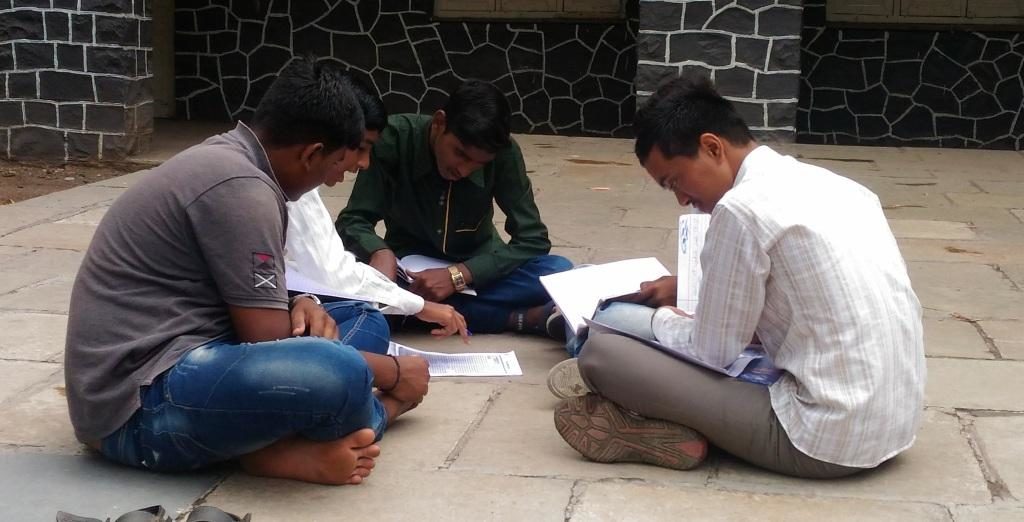GREAT Foundation was born in the classrooms of IIT Bombay. I had joined the HSS Department in 1974 to teach English. Aged 24, I was no social worker; just another idealistic young person who had joined the teaching profession out of love for the vocation. My life’s mission was to teach and help students. I had no vision, not even a career path. Then things happened. The very first class I went to teach was that of SC/ST students selected into IITBombay on reserved entry as it was then called. Meeting the poorly clad students with stars in their eyes was a new experience. Until then I hadn’t even known that there was a class of people called the SCs and STs. 1973 was the first year that students in this category had been selected into an IIT. Their selection had been mandated down to zero marks in the JEE by the Indian government eager to turn the wheel of caste inequality full circle, quickly.
Like my colleagues – Dipan Ghosh (Physics), Deepak Chakrabarty (Chemistry), Bal Mohan Limaye (Maths) and Neelima Talwar(English)–I began teaching the students. Like them I got involved in the narrative of their struggles in a meritocratic institute. Inspired by Dean Hiralal, each teacher did their best to strengthen the students academically and support them psychologically. We read Paulo Friere’s Pedagogy of the Oppressed, and Jean Piaget’s work on cognitive learning to prepare ourselves to give our best.
When the students were promoted from the Preparatory Course to First Year in 1975, we were happy but a bit worried too. Only one of the students who had taken the JEE 1975 could get selected, again on a reserved seat. The students had become part of the mainstream. That is when their travails began. Under prepared and deficient in Physics, Chemistry, Maths and English, in spite of the Preparatory Course, these students went down like a pack of cards to their peers who had been school/college toppers. With every passing day they became chronic back-loggers. Asked to leave for underperforming, they were now neither fit for IIT nor the outside world where deadlines for college admissions had lapsed. Except one student, Suryakant. He had the wherewithal and was very hard working. He alone among his batch cleared his B.Tech. with a CPI of 7.5 which was an achievement.
That is when their travails began. Underprepared and deficient in Physics, Chemistry, Maths and English, in spite of the Preparatory Course, these students went down like a pack of cards to their peers who had been school/college toppers.
Twenty three years in an institute is not a small period. As I grew older with the institute, new groups of students kept joining in the affirmative action category. Twice I was their Faculty Advisor. I realised the injustice being done to the students by inviting underprepared students to join the IITs and lost no opportunity in creating awareness about the wrongness of the act. Articles, lectures and a book on the subject followed. The theme was the same: ‘Select the best students among the community’; ‘Do not lower standards of intake’; ‘We must not spoil the lives of the students’.

IITian Viren teaching Logical Math
In 1977, a Senate committee was appointed to review the policy of intake under the Chairmanship of Prof RE Bedford. I was fortunate enough to be part of that committee. The Institute revised its intake policy to limit the selection to those who had scored at least two-thirds of the marks of the last-ranking student in the JEE. The new entrants had better conceptual preparation. Many of them stayed on to complete their B. Tech. even if they took an extra year, a benefit allowed to all IIT students. Some were good enough to be admitted directly into the First Year.
In 1997, I took voluntary retirement. In 2002, I set up a Trust named GREAT Foundation in Pune along with my brother, an IIT Bombay alumnus of the 1973 batch. Between 2002 and 2015, the NGO took up many projects aiming to improve the knowledge of Science, Maths and English in less privileged students studying in government schools. However we made little headway as we were permitted limited access to the students. Although we set up labs in schools and trained over 350 teachers in interactive teaching methods, sent volunteers to teach, our efforts were invariably outweighed by the inputs given in school. There were short-term gains such as spikes in students’ marks after a year’s intervention. A few enthusiastic teachers welcomed the initiatives. The rest could not be changed including many Principals.
Uninterested and bored teachers burdened with heavy non-academic duties hardly enjoy an NGO’s visit to their schools.
Uninterested and bored teachers burdened with heavy non-academic duties hardly enjoy an NGO’s visit to their schools. As long as one provides kits and helps the students do the activities, they seem happy. Once your project in the school ends, they too stop using kits and activities to teach and go back to their old ways.

Enjoying the e-content lesson
Last year, after much deliberation, our Board decided to focus on two main projects– Project STEM and Project Udaan. Under Project STEM we decided to train teachers to use technology to teach. Interactive e-content is provided to the schools to enable teachers to transfer concepts in Science, Maths and English more effectively. We support teachers through weekly visits until the use of e-content becomes a habit for them. Simply providing digital content without training teachers sufficiently is of no use. We are currently offering e-content and training/consultation in 5 government schools.
Under the other program, named Project Udaan, which means to fly, we select 40 bright less privileged Std 9 students through objective entrance tests and interviews, and coach them for 4 years in Physics, Chemistry , Maths, Logical Maths and English to prepare them for the JEE. Currently we have two batches running–Std 9 and Std 10. Part-time faculty– all engineers with an IIT-JEE orientation– train the students 6 hours a day for 75 days in the year.
Illiterate fathers have been one huge challenge. They have pulled out at least 10 girl students from the course. This is in spite of regular counselling and parental meetings.
In this program, at first the students are taught the school syllabus for concept clarification. Then the students are taught the IIT Foundation Course. Needless to say, this is a course for brave hearts. Of the 67 students we began with this year, we are left with 32 now. This is inevitable as only those students who are more diligent, highly motivated and can stand the pressure of both school and the Foundation Course will survive. We also do not force anyone to continue against their wish. The course, offered free of cost to students whose parental income is less than Rs. 2.5 lakhs, leaves ample scope for students to leave if they find the going tough.
The good news though is that the students who have survived in the course are steadily improving their academic performance. Our focus is on strengthening their concepts, inculcating habits of hard work and giving them daily practice in how to solve problems. We are waiting to see how well they perform in their SSC Board exams. Can they vault over the 95% bar? Those who can–be they 2,3,5 or 10 – will be the ones who will be selected for the two-year Advanced level JEE coaching.

Project Udaan: Solving Math Problems in groups
A six member team of GREAT Foundation is working exclusively with the students. An MIS system is used to track performance. Two IITians – Virendra Talim (1990 batch) and YN Sridhar (2005 batch) –teach Maths and Logical Maths every week. They support and guide us on how to design the program further.
Of all the projects we have done in the last 15 years, Project Udaan is the one that gives our team and me immense personal satisfaction. For the first time we feel that we are in control of our goal. There is dedication and commitment in the team as we face numerous challenges. Illiterate fathers have been one huge challenge. They have pulled out at least 10 girl students from the course. This is in spite of regular counselling and parental meetings. The program is monitored and evaluated on a continuous basis. Students are regularly trained in English to help them understand lectures and test papers. If well-trained students can get into the IITs, albeit on reservation, they will surely succeed.
The success of the first batch will make all the difference. Even if 5 students clear the JEE/ JEE Main to join an NIT or an IIT, the impact on other students, the schools and the parents is bound to be stupendous.
At 68, I still am no social worker. I do not know the ways that NGOs commonly employ to raise big funds for their projects.I remain an educationist whose eye is fixed solely on one goal –to strengthen the conceptual foundations of less privileged students who cannot afford good schools. I want to see these students pass out as engineers and scientists from national level colleges like the IITs,and on merit. It is the only way that reservations can succeed or can be stopped. It is also the only way such students can bid goodbye to intergenerational poverty and to stigmas of caste and class.
For the last two years, IITians from the Pune Chapter of IITBAA have stood beside me in the pursuit of this dream. Around 40 to 50 provide financial support to the project. The YP Orchestra has pledged to perform yearly in Pune in support of GREAT Foundation.
The year 2020 could well give fruition to a small miracle. We are learning from our mistakes as we move forward. One of the first matters that we would like to address is how to retain more girls in the program.

2 comments
Excellent Viney
[…] article was originally published in Fundamatics.net. The views expressed are […]